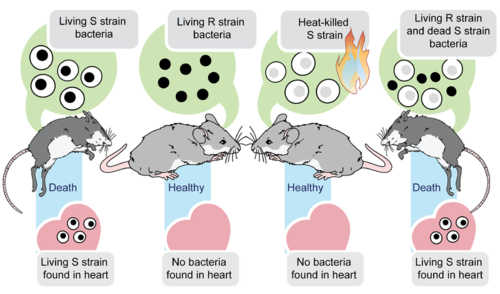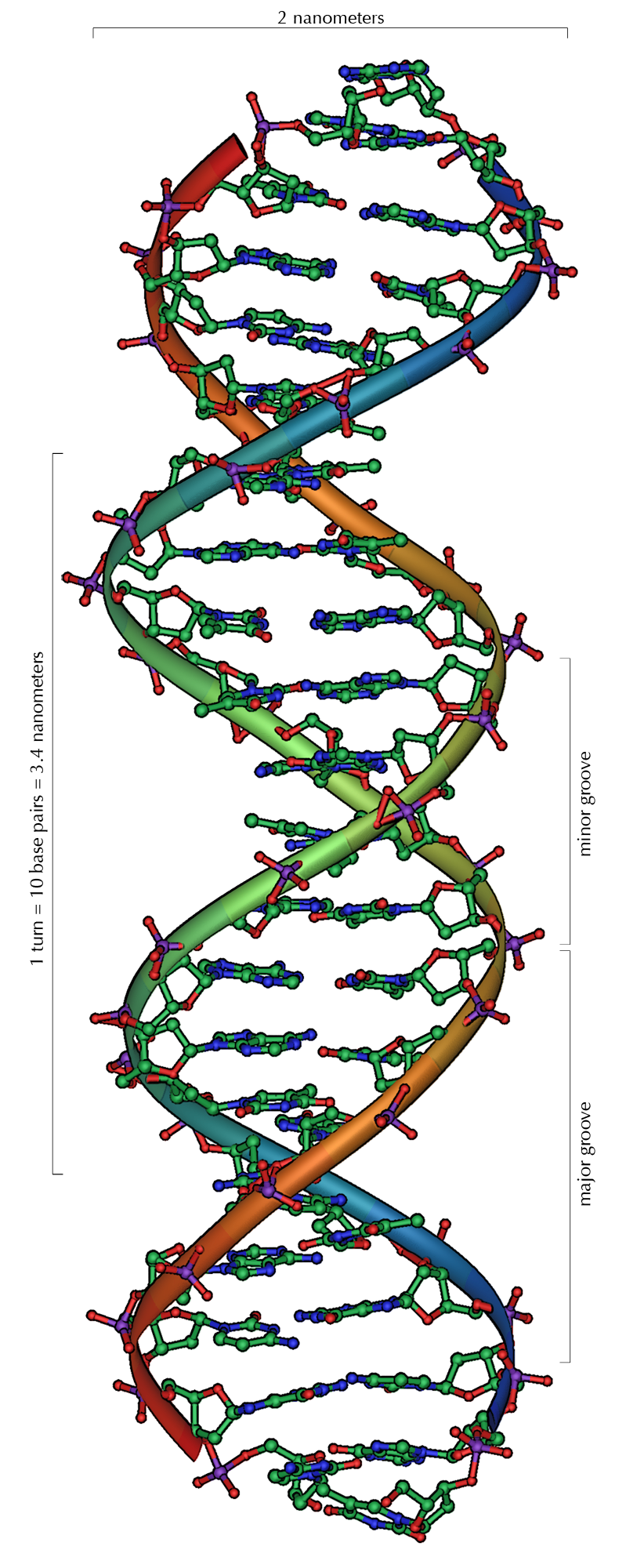43 5.3 DNA
Created by: CK-12/Adapted by Christine Miller

What Makes You…You?
This young woman has naturally red hair (Figure 5.3.1). Why is her hair red instead of some other colour? In general, what gives her the specific traits she has? There is a molecule in human beings and most other living things that is largely responsible for their traits. The molecule is large and has a spiral structure in eukaryotes. What molecule is it? With these hints, you probably know that the molecule is DNA.
Introducing DNA
Today, it is commonly known that DNA is the genetic material that is passed from parents to offspring and determines our traits. For a long time, scientists knew such molecules existed — that is, they were aware that genetic information is contained within biochemical molecules. What they didn’t know was which specific molecules play this role. In fact, for many decades, scientists thought that proteins were the molecules that contain genetic information.
Discovery that DNA is the Genetic Material
Determining that DNA is the genetic material was an important milestone in biology. It took many scientists undertaking creative experiments over several decades to show with certainty that DNA is the molecule that determines the traits of organisms. This research began in the early part of the 20th century.
Griffith’s Experiments with Mice

One of the first important discoveries was made in the 1920s by an American scientist named Frederick Griffith. Griffith was studying mice and two different strains of a bacterium, called R (rough)-strain and S (smooth)-strain. He injected the two bacterial strains into mice. The S-strain was virulent and killed the mice, whereas the R-strain was not virulent and did not kill the mice. You can see these details in Figure 5.3.2. Griffith also injected mice with S-strain bacteria that had been killed by heat. As expected, the dead bacteria did not harm the mice. However, when the dead S-strain bacteria were mixed with live R-strain bacteria and injected, the mice died.
Based on his observations, Griffith deduced that something in the dead S-strain was transferred to the previously harmless R-strain, making the R-strain deadly. What was this “something?” What type of substance could change the characteristics of the organism that received it?
Avery and His Colleagues Make a Major Contribution
In the early 1940s, a team of scientists led by Canadian-American Oswald Avery tried to answer the question raised by Griffith’s research results. First, they inactivated various substances in the S-strain bacteria. Then they killed the S-strain bacteria and mixed the remains with live R-strain bacteria. (Keep in mind that the R-strain bacteria normally did not harm the mice.) When they inactivated proteins, the R-strain was deadly to the injected mice. This ruled out proteins as the genetic material. Why? Even without the S-strain proteins, the R-strain was changed (or transformed) into the deadly strain. However, when the researchers inactivated DNA in the S-strain, the R-strain remained harmless. This led to the conclusion that DNA — and not protein — is the substance that controls the characteristics of organisms. In other words, DNA is the genetic material.
Hershey and Chase Confirm the Results
The conclusion that DNA is the genetic material was not widely accepted until it was confirmed by additional research. In the 1950s, Alfred Hershey and Martha Chase did experiments with viruses and bacteria. Viruses are not cells. Instead, they are basically DNA (or RNA) inside a protein coat. To reproduce, a virus must insert its own genetic material into a cell (such as a bacterium). Then, it uses the cell’s machinery to make more viruses. The researchers used different radioactive elements to label the DNA and proteins in DNA viruses. This allowed them to identify which molecule the viruses inserted into bacterial cells. DNA was the molecule they identified. This confirmed that DNA is the genetic material.
Chargaff Focuses on DNA Bases
Other important discoveries about DNA were made in the mid-1900s by Erwin Chargaff. He studied DNA from many different species and was especially interested in the four different nitrogen bases of DNA: adenine (A), guanine (G), cytosine (C), and thymine (T). Chargaff found that concentrations of the four bases differed between species. Within any given species, however, the concentration of adenine was always the same as the concentration of thymine, and the concentration of guanine was always the same as the concentration of cytosine. These observations came to be known as Chargaff’s rules. The significance of the rules would not be revealed until the double-helix structure of DNA was discovered.
Discovery of the Double Helix

After DNA was shown to be the genetic material, scientists wanted to learn more about its structure and function. James Watson and Francis Crick are usually given credit for discovering that DNA has a double helix shape, as shown in Figure 5.3.3. In fact, Watson and Crick’s discovery of the double helix depended heavily on the prior work of Rosalind Franklin and other scientists, who had used X-rays to learn more about DNA’s structure. Unfortunately, Franklin and these others have not always been given credit for their important contributions to the discovery of the double helix.
The DNA molecule has a double helix shape — the same basic shape as a spiral staircase. Do you see the resemblance? Which parts of the DNA molecule are like the steps of the spiral staircase?
The double helix shape of DNA, along with Chargaff’s rules, led to a better understanding of DNA. As a nucleic acid, DNA is made from nucleotide monomers. Long chains of nucleotides form polynucleotides, and the DNA double helix consists of two polynucleotide chains. Each nucleotide consists of a sugar (deoxyribose), a phosphate group, and one of the four bases (adenine, cytosine, guanine, or thymine). The sugar and phosphate molecules in adjacent nucleotides bond together and form the “backbone” of each polynucleotide chain.
Scientists concluded that bonds between the bases hold together the two polynucleotide chains of DNA. Moreover, adenine always bonds with thymine, and cytosine always bonds with guanine. That’s why these pairs of bases are called complementary base pairs. Adenine and guanine have a two-ring structure, whereas cytosine and thymine have just one ring. If adenine were to bond with guanine, as well as thymine, for example, the distance between the two DNA chains would vary. When a one-ring molecule (like thymine) always bonds with a two-ring molecule (like adenine), however, the distance between the two chains remains constant. This maintains the uniform shape of the DNA double helix. The bonded base pairs (A-T and G-C) stick into the middle of the double helix, forming the “steps” of the spiral staircase.
5.3 Summary
- Determining that DNA is the genetic material was an important milestone in biology. One of the first important discoveries was made in the 1920s, when Griffith showed that something in virulent bacteria could be transferred to nonvirulent bacteria, making them virulent, as well.
- In the early 1940s, Avery and colleagues showed that the “something” Griffith found in his research was DNA and not protein. This result was confirmed by Hershey and Chase, who demonstrated that viruses insert DNA into bacterial cells so the cells will make copies of the viruses.
- In the mid-1950s, Chargaff showed that, within the DNA of any given species, the concentration of adenine is always the same as the concentration of thymine, and that the concentration of guanine is always the same as the concentration of cytosine. These observations came to be known as Chargaff's rules.
- Around the same time, James Watson and Francis Crick, building on the prior X-ray research of Rosalind Franklin and others, discovered the double-helix structure of the DNA molecule. Along with Chargaff’s rules, this led to a better understanding of DNA’s structure and function.
- Knowledge of DNA’s structure helped scientists understand how DNA replicates, which must occur before cell division occurs so each daughter cell will have a complete set of chromosomes.
5.3 Review Questions
- Outline the discoveries that led to the determination that DNA (not protein) is the biochemical molecule that contains genetic information.
- State Chargaff’s rules. Explain how the rules are related to the structure of the DNA molecule.
- Explain how the structure of a DNA molecule is like a spiral staircase. Which parts of the staircase represent the various parts of the molecule?
-
- Why do you think dead S-strain bacteria injected into mice did not harm the mice, but killed them when mixed with living (and normally harmless) R-strain bacteria?
- In Griffith’s experiment, do you think the heat treatment that killed the bacteria also inactivated the bacterial DNA? Why or why not?
- Give one example of the specific evidence that helped rule out proteins as genetic material.
5.3 Explore More
The Discovery of the Structure of DNA, OpenMind, 2017.
Rosalind Franklin: Great Minds, SciShow, 2013.
Attributions
Figure 5.3.1
Redhead [photo] by Hichem Dahmani on Unsplash is used under the Unsplash License (https://unsplash.com/license).
Figure 5.3.2
Griffith’s mice by Mariana Ruiz Villarreal [LadyofHats] for CK-12 Foundation is used under a
CC BY-NC 3.0 (https://creativecommons.org/licenses/by-nc/3.0/) license.
 ©CK-12 Foundation Licensed under
©CK-12 Foundation Licensed under ![]() • Terms of Use • Attribution
• Terms of Use • Attribution
Figure 5.3.3
DNA_Overview by Michael Ströck [mstroeck] on Wikimedia Commons is used under a CC BY SA 3.0 (http://creativecommons.org/licenses/by-sa/3.0/) license.
References
Brainard, J/ CK-12. (2012). Concentration. In Physical Science [website]. CK12.org. https://www.ck12.org/c/physical-science/concentration/?referrer=crossref
OpenMind. (2017, September 11). The discovery of the structure of DNA. YouTube. https://www.youtube.com/watch?v=V6bKn34nSbk&feature=youtu.be
SciShow. (2013, July 9). Rosalind Franklin: Great minds. YouTube. https://www.youtube.com/watch?v=JiME-W58KpU&feature=youtu.be
Wikipedia contributors. (2020, June 27). Alfred Hershey. In Wikipedia. https://en.wikipedia.org/w/index.php?title=Alfred_Hershey&oldid=964789559
Wikipedia contributors. (2020, June 5). Erwin Chargaff. In Wikipedia. https://en.wikipedia.org/w/index.php?title=Erwin_Chargaff&oldid=960942873
Wikipedia contributors. (2020, June 29). Francis Crick. In Wikipedia. https://en.wikipedia.org/w/index.php?title=Francis_Crick&oldid=965135362
Wikipedia contributors. (2020, July 6). Frederick Griffith. In Wikipedia. https://en.wikipedia.org/w/index.php?title=Frederick_Griffith&oldid=966352134
Wikipedia contributors. (2020, July 5). James Watson. In Wikipedia. https://en.wikipedia.org/w/index.php?title=James_Watson&oldid=966111944
Wikipedia contributors. (2020, March 31). Martha Chase. In Wikipedia. https://en.wikipedia.org/w/index.php?title=Martha_Chase&oldid=948408219
Wikipedia contributors. (2020, July 2). Oswald Avery. In Wikipedia. https://en.wikipedia.org/w/index.php?title=Oswald_Avery&oldid=965632585
Wikipedia contributors. (2020, June 30). Rosalind Franklin. In Wikipedia. https://en.wikipedia.org/w/index.php?title=Rosalind_Franklin&oldid=965334881
Deoxyribonucleic acid - the molecule carrying genetic instructions for the development, functioning, growth and reproduction of all known organisms and many viruses.
The part of each hemisphere of the cerebrum that is involved in functions such as touch, reading, and arithmetic.
The rules developed by Erwin Chargaff stating that in a double stranded strand of DNA, the amount of adenine is always equal to the amount of thymine, and the amount of guanine is always equal to the amount of cytosine.
One of the structural components, or building blocks, of DNA and RNA. A nucleotide consists of a base (one of four chemicals: adenine, thymine, guanine, and cytosine) plus a molecule of sugar and one of phosphoric acid.
A molecule that can undergo polymerization, creating macromolecules. Large numbers of monomers combine to form polymers in a process called polymerization.
Complementary base pairing is the phenomenon where in DNA, guanine always hydrogen bonds to cytosine, and adenine always binds to thymine. In RNA, guanine always hydrogen bonds with cytosine, and adenine always hydrogen bonds with uracil.

